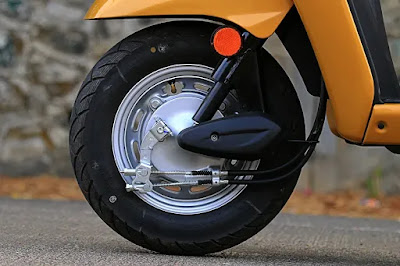Scooters are often used as a way to get around that’s both good on fuel as well as easy on the pocket. They generally weight less than motorcycles but are also slower. However, the type of wheels that you have on a scooter, whether they’re big or small, can make a lot of difference.
More common these days are that scooters are getting 12” and 13” inch wheels. So what is the advantage?
Using small tyres in a scooter provides additional space between the seat and tyre, where you can mount the engine and transmission. Because of small size only, this space is available. Hence the scooter is compact, has under seat storage and space at front for keeping your legs and goods.
Also, small wheels and tyres helps in incredibly quick steering. But again it leads to poor handling at higher speed.
So,the main reason for giving smaller wheels to scooters is to reduce the weight of the vehicle, increase the space requirement, and to offer a great manuvarity in city traffic.When it comes to poor handling at higher speed, scooters are not designed to run at high speed that is why smaller wheels are provided.
More common these days are that scooters are getting 12” and 13” inch wheels. So what is the advantage?
Using small tyres in a scooter provides additional space between the seat and tyre, where you can mount the engine and transmission. Because of small size only, this space is available. Hence the scooter is compact, has under seat storage and space at front for keeping your legs and goods.
Also, small wheels and tyres helps in incredibly quick steering. But again it leads to poor handling at higher speed.
So,the main reason for giving smaller wheels to scooters is to reduce the weight of the vehicle, increase the space requirement, and to offer a great manuvarity in city traffic.When it comes to poor handling at higher speed, scooters are not designed to run at high speed that is why smaller wheels are provided.





























